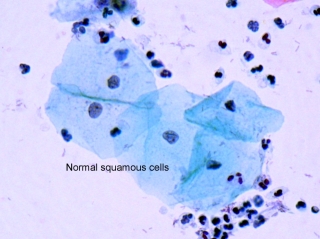Dysplasia
|
WikiDoc Resources for Dysplasia |
|
Articles |
|---|
|
Most recent articles on Dysplasia |
|
Media |
|
Evidence Based Medicine |
|
Clinical Trials |
|
Ongoing Trials on Dysplasia at Clinical Trials.gov Clinical Trials on Dysplasia at Google
|
|
Guidelines / Policies / Govt |
|
US National Guidelines Clearinghouse on Dysplasia
|
|
Books |
|
News |
|
Commentary |
|
Definitions |
|
Patient Resources / Community |
|
Patient resources on Dysplasia Discussion groups on Dysplasia Directions to Hospitals Treating Dysplasia Risk calculators and risk factors for Dysplasia
|
|
Healthcare Provider Resources |
|
Causes & Risk Factors for Dysplasia |
|
Continuing Medical Education (CME) |
|
International |
|
|
|
Business |
|
Experimental / Informatics |
Editor-In-Chief: C. Michael Gibson, M.S., M.D. [1]
- This article covers dysplasia, a pre-cancerous change in cells and tissues. For information about hip dysplasia, a clinical condition affecting the hip joint, please see the article on Hip dysplasia.
Overview


Dysplasia (from Greek, roughly: "bad form") is a term used in pathology to refer to an abnormality in maturation of cells within a tissue. This generally consists of an expansion of immature cells, with a corresponding decrease in the number and location of mature cells. Dysplasia is often indicative of an early neoplastic process. The term dysplasia is typically used when the cellular abnormality is restricted to the originating tissue, as in the case of an early, in-situ neoplasm. For example, epithelial dysplasia of the cervix (cervical intraepithelial neoplasia - a disorder commonly detected by an abnormal pap smear) consists of an increased population of immature (basal-like) cells which are restricted to the mucosal surface, and have not invaded through the basement membrane to the deeper soft tissues. Myelodysplastic syndromes, or dysplasia of blood-forming cells, show increased numbers of immature cells in the bone marrow, and a decrease in mature, functional cells in the blood.
Dysplasia, in which cell maturation and differentiation are delayed, can be contrasted with metaplasia, in which cells of one mature, differentiated type are replaced by cells of another mature, differentiated type.
Dysplasia vs. carcinoma in situ vs. invasive carcinoma
These terms are related since they represent the three steps in the progression of many malignant neoplasms (cancers) of epithelial tissues.
- Dysplasia is the earliest form of pre-cancerous lesion recognizable in a pap smear or in a biopsy by a pathologist. Dysplasia can be low grade or high grade (see "Carcinoma in situ", below). The risk of low grade dysplasia transforming into high grade dysplasia and, eventually, cancer is low. Treatment is usually straightforward. High grade dysplasia represents a more advanced progression towards malignant transformation.
- Carcinoma in situ , meaning 'cancer in place', represents the transformation of a neoplastic lesion to one in which cells undergo essentially no maturation, and thus may be considered cancer-like. In this state, cells have lost their tissue identity and have reverted back to a primitive cell form that grows rapidly and without regulation. However, this form of cancer remains localized, and has not invaded into tissues below the surface.
- Invasive carcinoma is the final step in this sequence. It is a cancer which has invaded beyond the original tissue layer and may be able to spread to other parts of the body (metastasize). Invasive cancer can usually be treated, but not always successfully. However, if left untreated it is almost always fatal.
References
- Richard Cote, Saul Suster, Lawrence Weiss, Noel Weidner (Editor). Modern Surgical Pathology (2 Volume Set). London: W B Saunders. ISBN 0-7216-7253-1.
- Ramzi S. Cotran, Vinay Kumar, Tucker Collins (Editor) (1999). Robbins Pathologic Basis of Disease, sixth edition. London: W B Saunders. ISBN 0-7216-7335-X.
- Dorland’s Illustrated Medical Dictionary, 1985, W.B. Saunders Company, Philadelphia